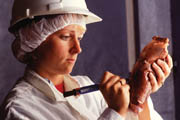
A number of sessions offered helpful advice to formulators attending the processed meats track of Prepared Foods' 2005 R&D Conference. This article focuses on various phosphates and meats.--Eds.
Functionality of Phosphates in Meat
In a topic describing how phosphates function in meat, Eugene Brotsky, technical service manager of meat, seafood and poultry at Innophos Inc., addressed specific value-added applications of phosphate use in meat products.Highly alkaline phosphates such as tetrasodium pyro and tripolyphosphate enhance protein's water-binding abilities. An increased water-holding capacity results in less moisture loss during cooking, and finished products with more tenderness and juiciness. In addition, alkaline phosphates improve binding in chopped and formed products by solubilizing actin and myosin proteins. Pyrophosphate and tripolyphosphate are best used for extracting soluble meat proteins for high-yield meats such as extended hams and turkeys. Adding sufficient salt (typically 1.5% to 2.0%) is important for achieving good yield during the phosphate extraction.
Polyphosphates inhibit warmed-over flavor and off-color caused by oxidation by sequestering or tying up iron and copper catalysts. Iron is present in meat as a component of the blood and muscle pigments hemoglobin and myoglobin, respectively, and copper is present in some seafood. These metals, released by cooking, accelerate flavor and color changes. Polyphosphates maintain fresh meat quality through extended storage by acting as metal-ion chelators.
Other factors such as color and flavor may be more important for consumer acceptance of medium-yield products such as pastrami and roast beef. Blends containing hexametaphosphate or sodium acid pyrophosphate often are used because alkaline phosphates can cause a grayish color and “soapy” flavor in certain products. A blend balances the needs for acceptable yield and lower pH.
Sausage products usually need less help with binding, because the process of finely chopping the meat with salt achieves most of the desired effect. Therefore, hot dogs, bologna and breakfast sausages usually use neutral pH phosphate blends composed of tripolyphosphate, hexametaphosphate and acid pyrophosphate. In fact, adding a high pH phosphate can cause excessive binding, resulting in a rubbery texture.
To be effective, phosphates must physically contact each protein molecule in order to chemically react. Therefore, injection must be used to contact the interior protein of a larger cut of meat (such as those weighing 4.4lbs. and more). Tumbling also provides mechanical action that aids the extraction, and is sufficient for smaller cuts of meat. Chopped meats need only to be mixed with a phosphate solution.
“How do Phosphates Function in Meat?” Eugene Brotsky, Innophos Inc., Eugene.Brotsky@ innophos.com, www.innophos.com.